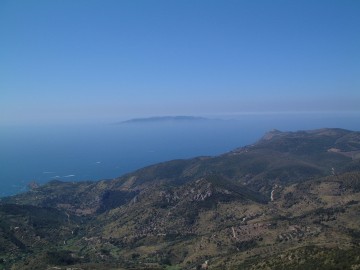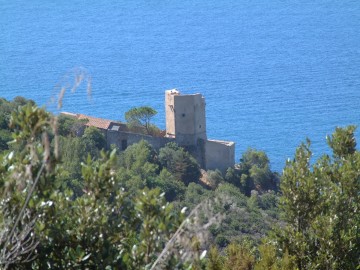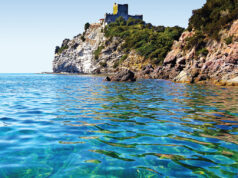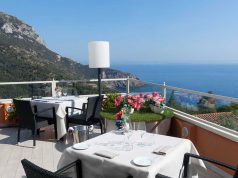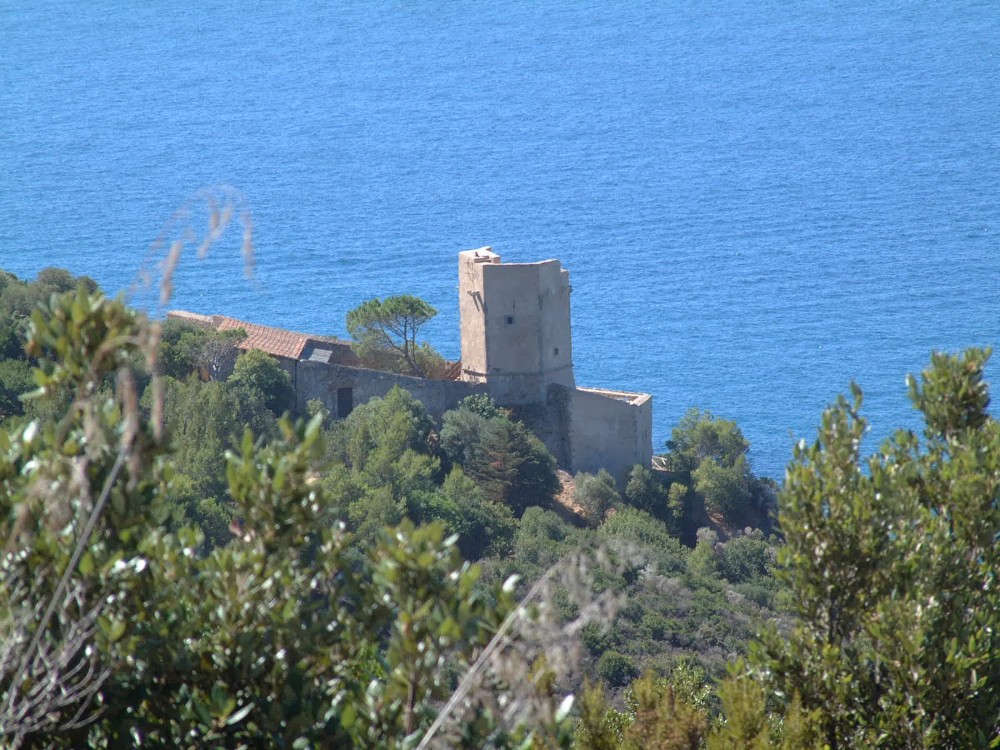
È un sistema difensivo imponente fatto di torri costiere e fortezze quello che con i conti Aldobrandeschi, successivamente con la Repubblica di Siena e soprattutto con la Corona Spagnola (dal 1559) nasce e si consolida sul promontorio di Monte Argentario, avamposto centrale nel Mar Tirreno contro i Saraceni / It is a massive defense system with coastal towers and fortresses the one that was created and reinforced by the Aldobrandeschi Counts, then later with the Republic of Siena and above all with the Spanish Crown (from 1559), on the Monte Argentario promontory, central outpost in the Thyrennian Sea against the Saracens
Testo di Gian Luca Gozzo – Traduzione di Gemma Bancalà
****
È facile che chiunque nasca e viva in un determinato luogo lo consideri unico al mondo. Spero si possa perdonare chi scrive queste poche righe sull’Argentario, se tale è la sensazione che avrà il lettore.
Tuttavia, è vero: il promontorio dell’Argentario per le sue caratteristiche fisiche, morfologiche, paesaggistiche e geografiche è un luogo straordinario. È infatti un’isola, dalla costa spesso alta e scogliosa, nel centro del Tirreno “legata” all’Italia da tre istmi; peculiarità queste che ne hanno fatto la fortuna e la sfortuna nel corso della sua storia.
Innumerevoli sono le tracce rinvenute che confermano la presenza umana fin dalla Preistoria, ma le testimonianze oggi a noi più visibili restano sicuramente le tante costruzioni militari disseminate sulla costa o nel suo immediato entroterra. Forse già nell’età del Bronzo, ma sicuramente con i conti Aldobrandeschi, successivamente con la Repubblica di Siena e soprattutto con la Corona Spagnola (dal 1559) che nasce e si consolida un sistema difensivo costituito di torri costiere e fortezze, originale nella sua disposizione in un territorio così limitato.
Del resto c’era da difendersi contro i pirati: “Mamma li Turchi!” probabilmente si diceva anche da noi, ma, benché il primo circuito difensivo, soprattutto su Porto Ercole, lo iniziarono i senesi, doveva avere un’inflessione spagnola dato che fu la Spagna ad investire in maniera importante nel sistema difensivo.
Una volta ottenuto il territorio dei Reali Presidi di Toscana col trattato di Cateau Cambrésis, la Spagna vide bene di migliorare e integrare quanto costruito fino ad allora, completando un poderoso sistema difensivo, avamposto centrale nel Mar Tirreno contro i Saraceni. Dalla fine dello Stato dei Presidi (1559-1801), col passaggio alla Francia napoleonica, la difesa costiera del promontorio andò a perdere d’importanza e, salvo la costruzione di un moderno forte al Pozzarello nei primi anni del Regno d’Italia (1884-1888), le costruzioni militari cominciarono a ritagliarsi il ruolo di “patrimonio storico-paesaggistico” che hanno oggi.
Non tutte le torri oggi sono in perfetto stato di conservazione, come la torre di S. Liberata, quella della Cacciarella, di Capo d’Omo; di altre non ce n’è più traccia, se non documentale (Fortino di Tre di Natale, la torre del Pagatore, del Calvello, del Pertuso).
In alcuni casi sono diventati immobili privati (come le torri di Cala Grande o di Lividonia e la Rocca di Porto Ercole e Forte Filippo… ben conservate e restaurate), in altri musei (la Fortezza Spagnola e Forte Stella), in altri ancora attendono una loro valorizzazione (Forte Pozzarello), ma ormai tutte fanno parte della singolare natura del Monte Argentario. E quindi luoghi da visitare, punti panoramici e di arrivo di percorsi interni per escursioni trekking e in mountain bike. E poi – perché no? – sfondi per immancabili #selfie.
****
The Towers and Fortresses of Argentario
If you born and live in a specific place, you probably consider it unique in the world. I hope you will forgive who’s writing these few lines about Monte Argentario, if that is the impression you will perceive.
As a matter of fact, it is true: the Monte Argentario promontory is an extraordinary place because of its landscape and its physical, morphological and geographical characteristics. It is actually an island with a rocky and often high coast, set in the middle of the Thyrennian Sea and connected to the mainland by three isthmus. These peculiarities have been both its fortune and misfortune during the centuries.
Innumerable traces confirm the human presence since prehistoric times, but the most visible evidences are the many military constructions scattered along the coast and its hinterland. It’s in the Bronze Age maybe, but surely with the Aldobrandeschi Counts, then later with the Republic of Siena and above all with the Spanish Crown that a defense system with coastal towers and fortresses was created and reinforced.
After all, it was necessary to defend against wild pirates. Although the first defensive circuit construction, especially in Porto Ercole, was started by Siena, it was Spain that significantly invested in the defense system. Once obtained the territory of the Reali Presidi di Toscana (Royal presidia of Tuscany) thanks to the Treaty of Cateau-Cambrésis, Spain decided to improve and reinforce what had been built until then, completing a strong defense system, central outpost in the Thyrennian Sea against the Saracens. From the end of the Stato dei Presidi (1559-1801), during the Napoleonic France, the promontory coastal defense importance decreased and, except for the construction of a modern fort at the Pozzarello during the first years of the Regno d’Italia (the Kingdom of Italy, 1884-1888), the strongholds started getting the role of “landscape and historical heritage” they have today.
Not all the forts are well-conserved, as the S. Liberata, Cacciarella and Capo d’Omo Towers; only documentary traces remain of some others (Tre di Natale Fortress and Pagatore, Calvello and Pertuso Towers).
Some of them became private estate (as the Cala Grande and Lividonia Towers, the Rocca di Porto Ercole and the Forte Filippo, well-conserved and restored), some others museums ( the Fortezza Spagnola and the Forte Stella), others are waiting to be enhanced (Forte Pozzarello), but all of them are part of the unique nature of Monte Argentario by now.
So, places to visit, panoramic viewpoints, trekking and mountain bike itineraries point of arrival. And then – why not? – splendid settings for #selfie
Bibliografia-Bibliography: G. Della Monaca, D. Roselli, G. Tosi – Fortezze e Torri Costiere dell’Argentario, Giglio e Giannutri, Pitigliano 1996.
